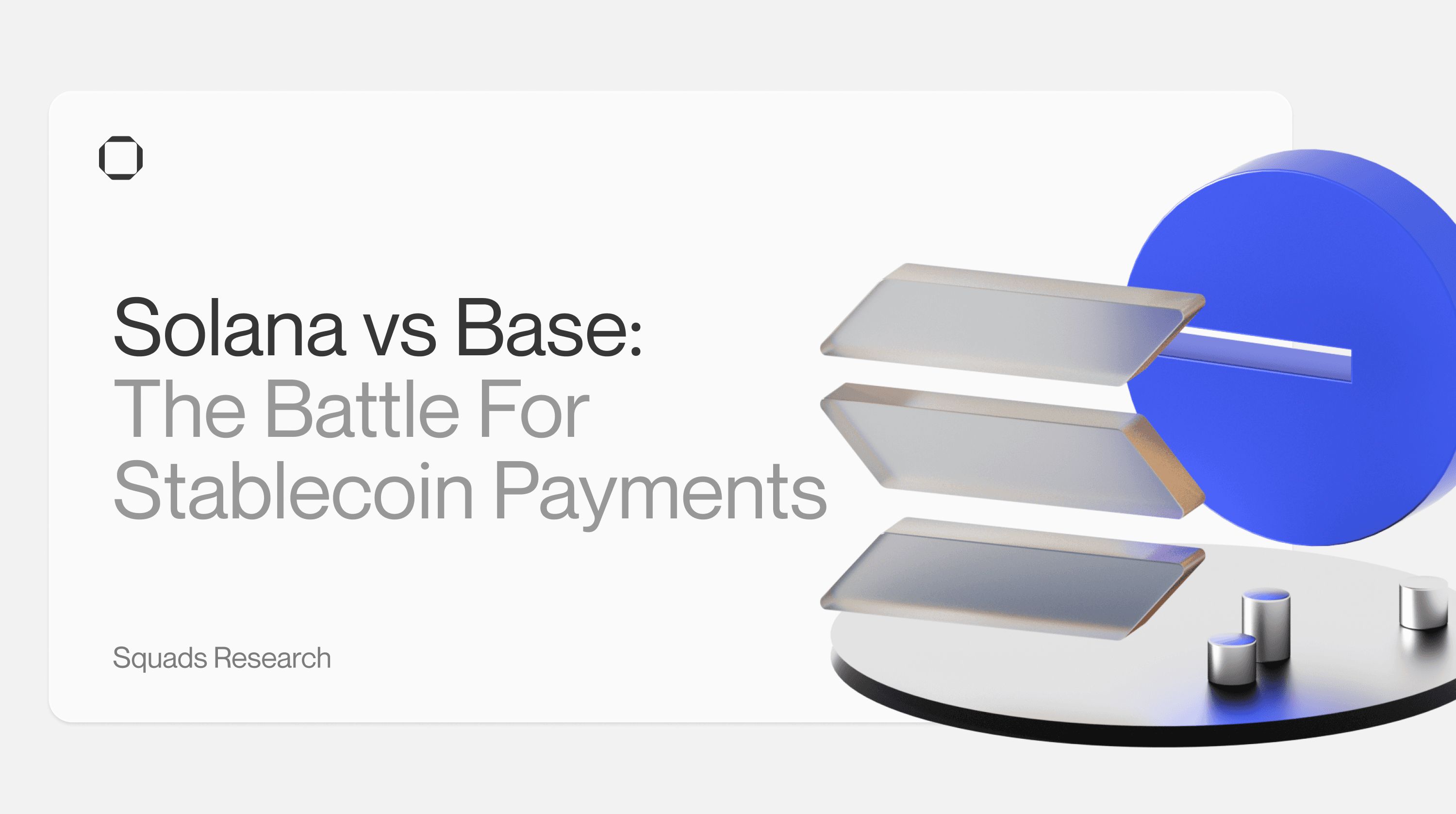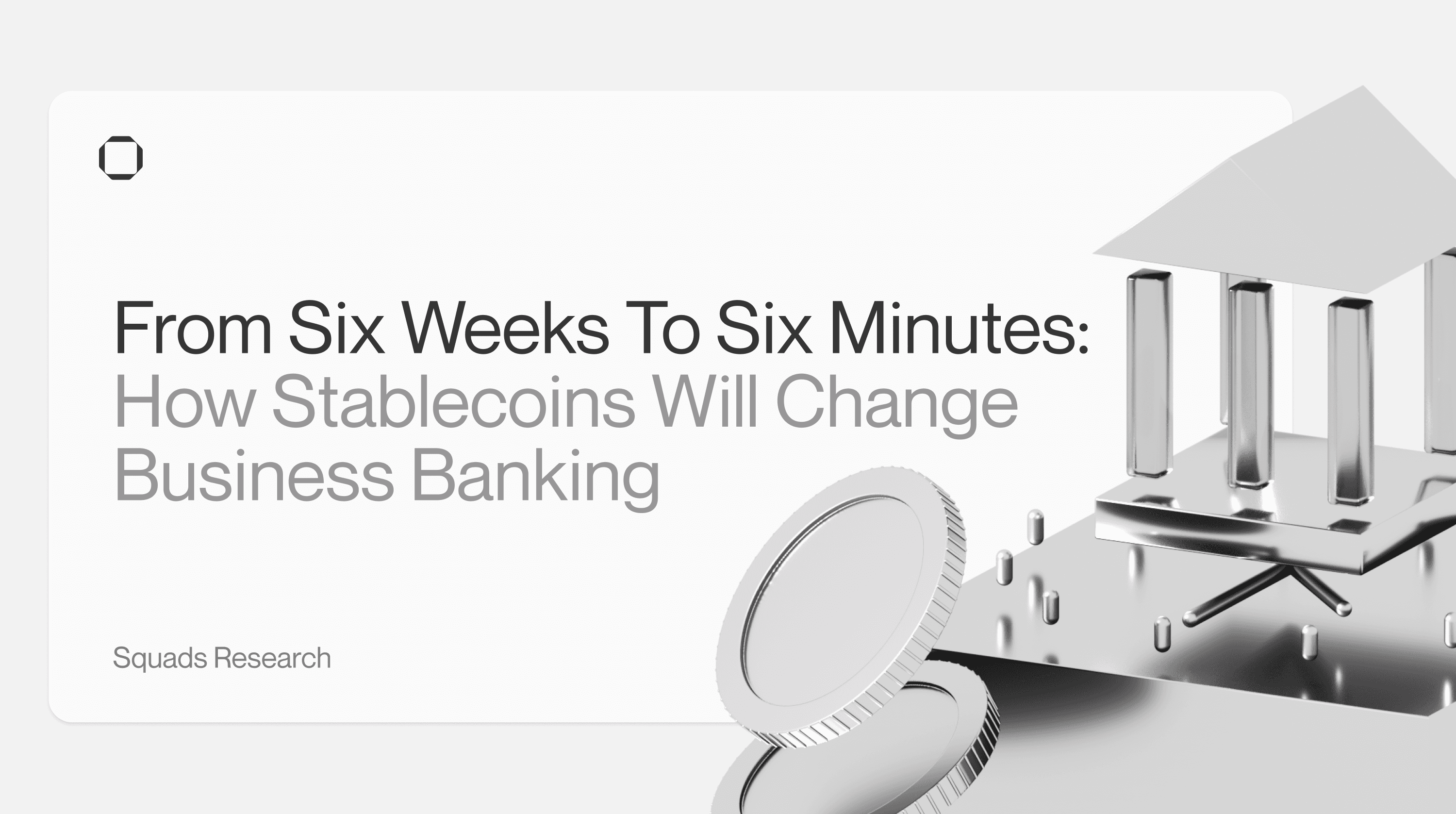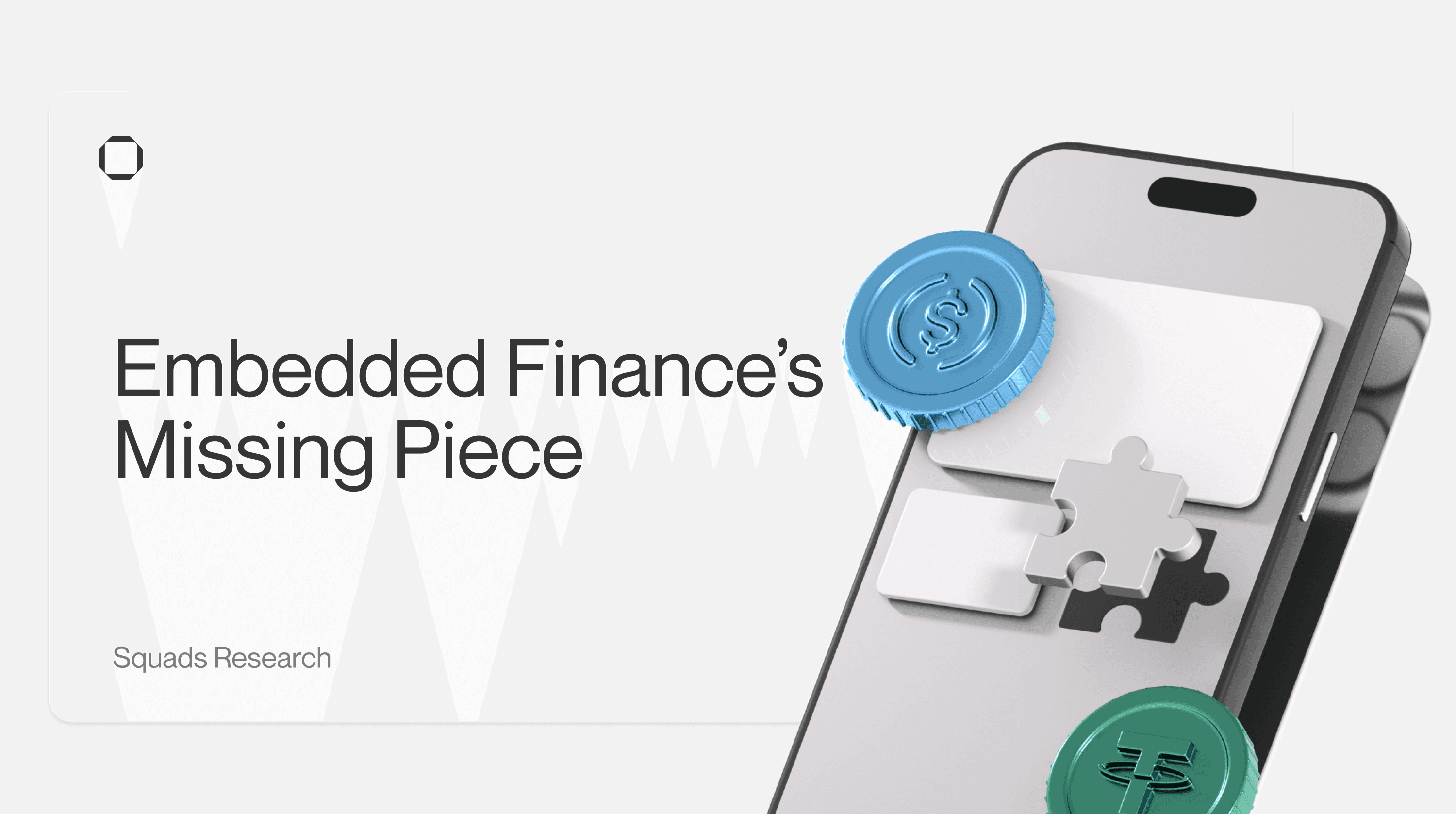At the time of President Donald Trump’s inauguration, stablecoins hit a record-breaking market cap of $210 billion—a snapshot of the larger story of how stablecoins are reshaping global money movements.
This growth is accompanied by increasing competition among companies to integrate stablecoins and their rails into their products and services. In October 2024, Stripe made headlines by acquiring Bridge, a stablecoin payments platform, for approximately $1.1 billion—marking the largest crypto acquisition ever. That same year, stablecoin payment companies secured over $309 million in funding, reflecting the growing confidence in the sector.

Blockchain ecosystems compete to position themselves as the ideal foundation for payment use cases, each with unique tradeoffs affecting implementation costs, user experience, and market reach. This report explores the key factors companies and developers should consider when choosing a blockchain platform to build stablecoin payment solutions, highlighting both Solana and Base as the most viable blockchains for payments today.
Onchain Payment Landscape
As covered in our previous report, stablecoins are evolving from a crypto-native tool into mainstream financial infrastructure, fundamentally reshaping how money moves:
Stablecoin annual volume surged from $5.7T in 2023 to $8.3T at the end of 2024.
Active stablecoin users span 29M addresses across major blockchains.
Stablecoins now drive 32% of daily crypto activity, second only to DeFi.

Crypto-native companies, legacy enterprises, and startups are embracing stablecoins and their rails, with adoption expanding across major industries, such as e-commerce ($25T+), B2B payments ($1.3T+), and remittances ($700B+).
For instance, SpaceX aggregates some of Starlink’s global revenue into stablecoins, bypassing foreign exchange risks. In late September 2024, PayPal conducted its first commercial stablecoin transaction using PYUSD, paying Ernst & Young through SAP's digital currency platform. Other major American retailers like Overstock, Chipotle, Whole Foods, and GameStop now accept stablecoins for payments.

This surge in enterprise adoption underscores a critical point: selecting the right blockchain infrastructure is no longer a trivial choice—it’s a strategic necessity that will define a company’s competitiveness in the rapidly evolving digital payments ecosystem.
Evaluating Blockchains For Stablecoin Payments
The successful integration of stablecoins and their rails into products or services requires a blockchain to meet four critical requirements:
Performant Architecture
Low/Predictable Fees
Market Demand
Regulatory Clarity
We will analyze these requirements across two public blockchains: Solana and Base.
You may be wondering why we selected these two blockchains. After all, Ethereum has the largest stablecoin TVL by a significant margin, Tron is one of the most popular blockchains for stablecoin payments, and Celo is driving significant stablecoin adoption through Minipay—Opera's mobile wallet that has onboarded over a million users across Africa.
While these blockchains have compelling strengths, they were ultimately excluded from our analysis based on the following factors:
Ethereum: While adequate for high-value transfers, Ethereum's prohibitively expensive gas fees and slow transaction speeds limit its stablecoin payment applications. This has led to a bifurcated ecosystem: Ethereum retains large balance holders while delegating payment apps and mainstream use cases to side-/appchains.
Tron: The blockchain ranks among the most active for stablecoin payments, particularly serving users without access to traditional financial rails. However, as covered in our previous report, its prevalence in sanctioned jurisdictions, controversial ties to Justin Sun, and reported usage by terrorist organizations have intensified regulatory scrutiny. With Circle's discontinuation of native USDC support in February 2024 and its diminishing ability to attract major stablecoin issuers, Tron is unlikely to emerge as a foundation for new stablecoin and payment apps.
Celo: While showing promising user adoption in Africa through Minipay, the blockchain faces significant headwinds: low TVL, limited institutional adoption, a young track record, and an evolving technical roadmap following its 2024 transition to an L2. Celo is a blockchain worth watching, but is unprepared for mainstream stablecoin payment applications.
There are, of course, other blockchains with thriving stablecoin payment applications, such as BNB, Arbitrum, Avalanche, and TON. While these blockchains have vast potential, they fail to meet the core criteria required for mainstream payment adoption that Solana and Base have achieved.
Beyond public blockchains, appchains such as SphereNet and Payy are also gaining attention in the stablecoin payments sector. However, no appchain has yet proven itself a dominant platform for stablecoins and payments, facing significant challenges with limited developer and user infrastructure, long-term neutrality questions, and difficulty attracting institutional adoption and stablecoin issuers.
Launching an appchain is akin to opening a Shopify store and attracting inbound traffic—but in the world of finance, where liquidity attracts more liquidity, the challenge is far greater.
With all this in mind, let’s look at the conditions that make Solana and Base viable for stablecoin payments today.
Performant Architecture
Stablecoin payment use cases require fast transactions, often measured in transactions per second (TPS) and blockchain finality. Solana and Base functionally achieve high TPS and fast finality, making them ideal for stablecoin payments.

TPS reflects a network's capacity and efficiency, with higher TPS indicating the ability to handle larger real-time activity volumes.

Finality refers to the time it takes for a transaction to be irreversibly confirmed. Fast and secure finality in payment systems is critical to ensure that transactions are irreversible and to prevent double-spend. If a blockchain cannot prevent double-spending, its purpose as a ledger is moot. Finality also gives users confidence that their transactions are settled and can be relied upon for financial agreements.
Solana and Base achieve finality through two different mechanisms:
Solana transactions reach two commitment (finality status) levels: confirmed and finalized. Confirmed transactions achieve supermajority (66% of stakeweight) consensus within 800 ms, while finalized transactions require 31 additional confirmed blocks (~13 seconds) for maximum security. In practice, no optimistically confirmed block has ever been reverted in the four years of Solana’s existence.
Base takes a different approach with its Coinbase-operated sequencer, offering near-instant preconfirmations with 2-second block times. These preconfirmations rely on Coinbase's reputation rather than economic incentives, and true finality takes ~15 minutes as transactions settle on Ethereum. The centralized sequencer design enables rapid iteration, fast confirmations, and reduces toxic MEV. It also introduces censorship risks and a single point of failure.
Low/Predictable Fees
Affordable and predictable fees are imperative for any payment use case, so businesses and users can anticipate transaction costs without concern for significant fluctuations.

A key component of Solana’s payment capabilities is that, unlike Ethereum L1/2s, it partitions database hot spots with local fee markets. Local fee markets and Jito’s transaction segmentation engine make Solana transactions affordable and predictable for the average user—a critical requirement for stablecoin payment applications. Solana's native parallelization further enhances throughput by executing multiple transactions simultaneously rather than sequentially.
Let’s also not forget the elephant in the room: Firedancer. Firedancer, an independent Solana validator client developed by Jump Crypto, has achieved 1M TPS in a testing environment and is expected to roll out in sequential phases later this year.
Meanwhile, Base operates on a single-threaded EVM, scaling through software optimizations and hardware. Its performance is increasing steadily, with a 2025 commitment to increase Base’s block capacity by 1 Mgas/s per week.
Further, Base’s sequencer transactions are processed offchain in batches before finalizing on Ethereum. This approach decouples user fees from Ethereum congestion, using only 8% of fee revenue for settlement despite consuming 40%+ of Ethereum's blob space.

Another key difference between Solana and Base is who benefits from the fees collected. On Solana, fees are paid to a decentralized validator set, while on Base, they go directly to Coinbase. In 2024 alone, Coinbase generated at least $56M in revenue from fees paid to its sequencer.

Solana fosters a diverse ecosystem of companies working on scaling solutions, from validator client optimizations to ZK state compression. Base lacks such diversity; instead, it leverages Optimism's OP stack and relies on Coinbase for its technical roadmap.
This reduces the surface area for Base’s innovation but enables faster adoption of breakthroughs as coordination costs are significantly reduced. Base can implement future upgrades and EVM research (e.g. Monad’s experimentation with parallelization and database optimizations for the EVM) at a rate faster than its decentralized counterparts—such as Solana.
Market Demand
Onchain payments are only viable when there is sufficient demand to use stablecoins as “money.” With onchain activity on Solana and Base at all-time highs, both blockchains are well-positioned for stablecoin payments.
A blockchain's “Real Economic Value” (REV) is the best proxy for user demand. Daily or monthly active users (DAUs/MAUs) are unreliable metrics for evaluating blockchain usage, as they can easily be sybiled. Inflating REV, on the other hand, is significantly more challenging and economically unfeasible. High REV, not DAUs/MAUs, signals to businesses and developers that a blockchain is a strong platform for commerce, sparking a powerful flywheel effect.
Solana
As of January 23, 2025, Solana leads all chains in REV, generating $751m in revenue in Q4 2024 alone.

Solana’s dominance is driven by its relative ease of onboarding, low fees, and robust DeFi applications—such as Jito, Jupiter, Kamino, Drift, Moonshot, and pump.fun. pump.fun, in particular, has led to an influx of trading activity and new users and has generated over $450M in fees since its launch in March 2024. This is a clear sign that viable businesses can be built on Solana.

Speaking of onboarding, on January 18, 2025, President Trump launched his official memecoin $TRUMP on Solana, generating over $7B of onchain trading volume within 24 hours. By January 19, 2025, Solana’s daily REV exceeded $56M, and Moonshot, which enables users to buy crypto with Apple Pay, became the US's #1 finance app in the App Store.

Other key indicators are the availability of stablecoins and the number of stablecoin payment applications being built. As of January 2025, Solana’s stablecoin TVL stands at $10.7B, an ATH. From January 15-21, 2025, over ~$3B in stablecoins were minted on Solana alone. This impressive growth signifies ample opportunity for stablecoin payment use cases.

For this reason, many stablecoin payment verticals have already been developed on Solana, such as cross-border payments, point of sale, debit cards, yield generation, and more.

Base
Despite having a significantly smaller TVL than Ethereum and Solana, Base boasts an impressive REV and stablecoin growth.

Today, Base is the world’s most widely used L2, and Coinbase increasingly stores user deposits on the blockchain—a significant milestone in the history of onchain economies.
Base’s users are unique, as most were likely onboarded directly from Coinbase, the US's largest centralized exchange (CEX). Coinbase commands a 45% market share in the US; as a result, many of Base’s users are likely North American. This metric is particularly impactful for American businesses looking to integrate onchain payments.
A significant contributor to Base’s success is its unique partnership with Circle. In 2018, USDC was co-launched by Circle and Coinbase, becoming the first stablecoin supported by the centralized exchange. Also, Coinbase was initially responsible for the underlying dollar backing of USDC as a key member of the now-discontinued Circle Consortium. As a subsidiary of Coinbase, Base offers unrivaled advantages to developers and users, such as free gas credits for applications, discounted gas fees for users when paid in USDC, and zero fees for USDC onramps.
Consequently, it is unsurprising that new native stablecoin payment applications exist on Base, such as Peanut, LlamaPay, Superfluid, and Acctual. That said, the overall stablecoin payment landscape on Base is significantly smaller than on Solana, with the caveat that Base still has a much younger ecosystem.
Regulatory Clarity
Solana and Base are currently in good standing from a regulatory perspective, and the incoming Trump administration may enhance regulatory clarity even further.
Compared to other blockchains, Base is in a unique position as it does not have a native token and, therefore, has faced no regulatory inquiry. The same cannot be said for Coinbase, which is still embroiled in an SEC lawsuit.
Moreover, Base’s design limits its neutrality in the face of shifting regulations. With its current design, Base could unilaterally geo-fence users, require KYC data for onchain operations, blacklist tokens/applications, freeze wallets, or require verification from Coinbase to operate on its blockchain. Coinbase attestations are already live, providing the tools needed to enforce these rules. In contrast, Solana operates across 1,000+ validators, ensuring that regulatory requirements are not centrally managed but instead enforced through frontends or token extensions.
Regulatory challenges for stablecoins and onchain payments are not insurmountable, and the adoption of blockchain technology by banks like Société Générale and Deutsche Bank or companies like Visa, Stripe, Venmo, PayPal, Robinhood, Nubank, and Revolut indicates that the benefits may outweigh these temporary risks.
Conclusion
Incumbents and startups looking to integrate stablecoins and onchain payments cannot ignore the rise of Solana and Base. Solana has a distinct edge in demand, a diverse ecosystem, and resistance to censorship. In contrast, Base holds an advantage with its strong presence in the US, connections with Coinbase, USDC subsidies, and rapid development pace.
The key differentiator is credible neutrality. We believe that Base will play a growing role in onboarding new companies and users, especially in the US. However, Solana will be the home of stablecoin payments in the long term.
Applications powering borderless money movement will gravitate toward Solana’s neutral substrate, built on distributed innovation rather than dependence on centralized sequencers governed by isolated incentives. Solana provides an unbiased and future-proof playground for companies and developers to create innovative stablecoin payment applications.
The race to build the next onchain payment super-app is intensifying—the time to start building is now.
If you found this research valuable, follow us on 𝕏 to stay updated on our latest research and insights.



